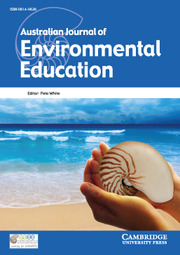The most recent State of the Climate report (CSIRO and Bureau of Meteorology, 2024), together with the Intergovernmental Panel on Climate Change Sixth Assessment Report (IPCC, Reference Core Writing, Lee and Romero2023) highlights the urgency of mitigating against and adapting to the changes to the climate. To name a few scientific projections: continued sea level rise, more frequent and intense marine heatwaves, a warmer climate, less snowfall, more intense and frequent fires as well as torrential rain. Outlining these projections, however, does not appear to be enough of a catalyst to increase pro-environmental behaviours (e.g. Kang & Tolppanen, Reference Kang and Tolppanen2024). Conversely, reading “Living with the Anthropocene,” a rich and beautifully curated collection of essays, highlights the stakes, both in Australia and globally, if we persist in blindly heading towards environmental catastrophe.
Through a brilliant compilation of experiences faced by individuals, communities and societies, this book compellingly demonstrates how the challenges caused by the Anthropocene, and the related cultural issues, might be tackled through stories that allow us to share, debate and find common ground on what truly matters and how we can act upon it. Hofman-Bergholm’s (Reference Hofman-Bergholm2022) recommendation for the use of storytelling as a climate change pedagogical approach to tackle complex themes such as climate literacy, social justice and equity, community, collaboration and interdependence through the narrative is perfectly executed in Living with the Anthropocene, allowing the reader to connect with these themes through relatable and engaging stories.
“Facing The Storm” articulates the stark realities of climate change. The experiences and perspectives in this chapter articulate the realities, vulnerabilities and the need for urgency in the face of climate change. “Tearing Away” shifts our focus from climate change as a distant, abstract concept to the realisation that it is unfolding now. Phrases like “Not all losses need to be visible or truly tragic to be meaningful” (p.53) encourage us to recognise the subtle impacts of climate change in our own lives. They prompt a deeper awareness that these seemingly small disruptions may reflect broader turmoil, stress and threats in other parts of the world.
Within the chapter “Seeking Vantage Points,” we are persuaded to see different perspectives on the complexities of climate change — from understanding the importance of fungi to the changing birdsong in the backyard and to the thriving brine shrimp as arguable winners in the Anthropocene. “Holding On” gently reminds us to slow down and truly notice the world around us, highlighting the importance of cultivating an appreciation for the aesthetic beauty of nature. It calls attention to the importance of understanding and protecting interconnected species — the chorus of cicadas, the scent of frangipani trees, the jacaranda bloom, the metallic rainbow sheen of Christmas beetles and ants vigilantly guarding butterfly larvae as they feast on sweet Bursaria. The power of resilience is beautifully conveyed in “Treading Water,” which explores peoples’ realisation that things once taken for granted are now at risk of disappearing. Against this backdrop of loss, stories of regeneration, innovation, hope and interconnection highlight the strength and adaptability needed to navigate change.
In the closing chapters, we are prompted to reflect on our own actions for the planet. “Regenerating Country” explores the dynamic relationship between time, legacy and forward-thinking, urging us to acknowledge the significance of the past — including the legacy we create — in shaping the future. Supported by Wang and Coren (Reference Wang and Coren2024), “Sharing a story” inspires us to listen to and write stories to engage, enable and empower individuals and communities in climate communication and action. The final chapter, Walking Together, concludes by emphasising that while the years ahead will be challenging, a theory of change — “focused on securing a planet capable of sustaining life in all its magnificent diversity” Greenpeace (2023, p.3) — can be realised through collective human effort. It shares a sense of hope that as compassionate and caring humans, we have the capability and the tools (such as with breakthroughs in clean-energy tech, regenerative agriculture, community) to bring about change for our future generations.
In a time of unpredictable environmental change caused by human impact on the Earth’s biophysical systems, an understanding of climate change beyond scientific knowledge is needed. The OECD’s Education Working Paper, “Agency in the Anthropocene” (White et al., Reference White, Ardoin, Eames and Monroe2023, p5), shares the importance of supporting an education that will enable (young) people to develop an “ethic of care and justice and an ecocentric worldview, which includes humans as part of the environment rather than separate from it.” Living with the Anthropocene speaks to all generations, highlighting the interconnectedness of humans with one another and with the diverse forms of life that share our planet. It emphasises our collective responsibility in the face of the Anthropocene. It takes us on a journey of exploring new ways to live (and perhaps thrive) in the face of environmental crisis. As an educator of future generations, this book (along with the resource of nature itself) will now be a resource that I will revisit as a constant reminder of what it truly means to be a global citizen of our shared planet.
Author biography
Amy Strachan is a lecturer in curriculum and pedagogy at the University of the Sunshine Coast, Queensland, has a research focus in science education, climate change education and teacher agency. Amy taught primary education for over 12 years across England, Japan and The Gambia, holding roles as a generalist, specialist science teacher and curriculum lead. She then became a senior lecturer in Primary Science Education at St Mary’s University, London, where she also led professional development for science teachers. Passionate about global learning and citizenship, Amy’s EdD research led to her award-winning resource Saving The Planet One Science Lesson At A Time. She co-authored The Really Useful Science Book and worked with the Department for Education and the Natural History Museum on climate education programmes.



